Setting Up Dual Monitors for Enhanced Productivity
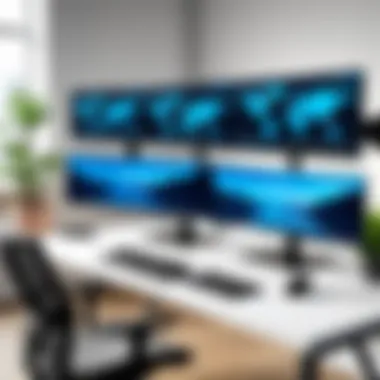
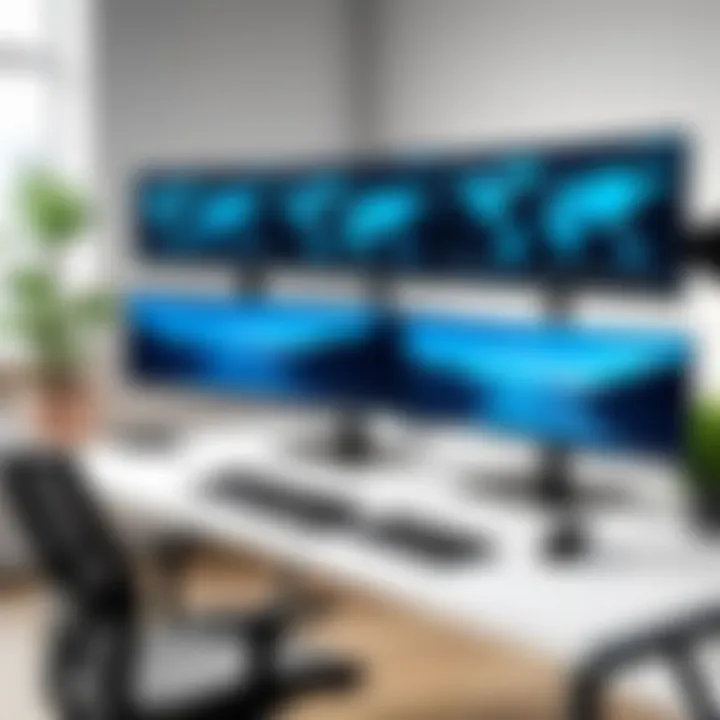
Intro
In today's fast-paced digital world, the need for efficiency and productivity is at an all-time high. Among the many strategies to boost workflow, establishing a dual monitor setup stands out as a game changer for both IT professionals and tech enthusiasts. By expanding your visual workspace, you can enhance multitasking capabilities, streamline tasks, and improve overall performance. However, getting started with such a configuration requires understanding its benefits, the necessary components, and how to put everything together effectively.
The Benefits of a Dual Monitor Setup
Working with two monitors can dramatically change the way you approach your daily tasks. Imagine being able to have your email open on one screen while working on reports or coding in a development environment on the other. This setup not only allows for better organization of workflow but also reduces the time spent switching between tabs and applications.
Some key advantages include:
- Increased Screen Real Estate: More space for open applications allows for greater visibility and easier navigation.
- Enhanced Multitasking: You can monitor progress on different tasks without losing focus.
- Better Collaboration: Sharing screens in meetings becomes a breeze when presenting content from one monitor while discussing it on the other.
Of course, with any system upgrade, there can be challenges. Understanding these potential hiccups from the get-go can simplify the transition and help avoid any missteps along the way.
Prelude to Dual Monitor Setups
In the realm of personal computing and professional environments, a dual monitor setup emerges as more than just a trend; it's a vital enhancement for productivity. With the increased demand for multitasking and seamless workflow, relying on a single screen can feel like trying to run a marathon in a pair of clogs. This section aims to shed light on the significance of integrating two monitors into your workspace, exploring specific elements that underline its benefits and considerations.
Definition of Dual Monitor Setup
A dual monitor setup refers to an arrangement where two computer monitors are used simultaneously. This configuration allows users to display different applications or data on each screen, effectively enlarging the workspace. For instance, a programmer might keep a code editor open on one screen while running tests or documentation on the other. This setup not only enhances visibility but also minimizes the time spent switching between tabs, translating to a more streamlined experience overall.
Historical Context and Evolution
The journey of dual monitor setups can be traced back to the mid-1990s when graphic designers and video editors began to recognize the advantages of expanded screen real estate. The compatibility of operating systems gradually improved, paving the way for wider adoption in the following decades. In the early days, a second monitor was often an afterthought, but as technology advanced, so did the design and functionality of monitors themselves. Transitioning from CRTs to flat screens, and now to ultra-wide monitors, the evolution has mirrored the increasing need for efficient workspace solutions.
As the digital landscape continues to expand, the innovations in dual monitor setups are not only becoming more prevalent but are also rapidly evolving. For example, portable display technology has emerged, allowing multiple displays to be connected without the traditional limitations of size and weight. Today's tech-savvy user, whether in a corporate office or working remotely, is more equipped than ever to optimize their productivity through a dual display configuration.
"The adoption of dual monitors is now a direct reflection of a user's desire to enhance their efficiency and adaptability in an ever-changing tech world."
In summary, establishing a dual monitor setup is no longer simply a nicety but rather a necessary approach to maximizing efficiency and productivity in any tech-driven environment.
Benefits of Using Dual Monitors
Dual monitor setups offer a variety of advantages that can greatly enhance the experience for technology professionals and avid computer users alike. With the expansion of workspace through an additional screen, users can harness the power of dual monitors for improved productivity, organization, and much more. It’s not just an aesthetic upgrade; it’s a practical shift that aligns with the growing demands of the modern work environment. In the following sections, we will delve into how dual monitor systems can absolutely transform the way tasks are approached, paving the way for more efficient workflows.
Enhanced Productivity
In the fast-paced world of technology and information management, the need for speed has never been more crucial. Dual monitors provide an immediate boost in productivity, allowing users to keep multiple applications open and within sight. The sheer capacity to manage various tasks simultaneously proves invaluable.
Improved Multitasking
This aspect of productivity cannot be overstated. Improved multitasking means users can seamlessly interact with different applications without endlessly switching between windows. For example, consider a marketer who needs to analyze data on one screen while drafting a report on the other. This fluidity between screens prevents interruption, allowing thought processes to flow without a hitch.
It's like having a personal assistant who has the required information at their fingertips, significantly cutting down response times.
However, it’s essential to remain mindful of potential distractions. Many users can find the added screen space overwhelming if not managed properly. Without a good organization strategy, the benefits may be counteracted by disarray and confusion.
Better Workflow Management
Efficient workflow management can make or break a project’s success. With dual monitors, tasks can be organized in a way that feels more natural.
For instance, a programmer can keep their coding window open on one screen while referencing documentation or a debugging tool on the other. This structure not only accelerates work but also minimizes errors born from miscommunication between applications.
Plus, being able to consult resources directly avoids the pitfalls of scattering digital notes across various tabs, fostering a more cohesive working environment.
Improved Organization
The essence of any effective work process is organization. This is where dual monitors shine, offering an expanded visual layout that lends itself to better task management.
Streamlined Applications
One of the remarkable characteristics of streamlined applications is their ability to minimize search times. Imagine opening a spreadsheet with financial data on one monitor while simultaneously monitoring communications via an email client on the other.
Things become significantly tidier when the clutter is reduced; streamlined applications allow users to maintain focus on priority tasks without unnecessary back-and-forth toggling. This makes task completion quicker and far less stressful.
One downside may be the temptation to keep too many applications open, which could inadvertently lead to overload. Thus, setting clear guidelines on what is essential for one’s workflow is critical to maximize the benefits of dual monitors.
Visual Data Management
Visual data management represents a notable key feature of dual monitor setups. The ability to visually arrange data across two screens enhances comprehension and allows for quicker analysis. For example, a financial analyst can plot data trends on one monitor while monitoring real-time updates on another.
Such an arrangement promotes a more comprehensive overview, helping professionals connect the dots faster and make timely decisions.
Nonetheless, clarity can sometimes suffer if data is poorly organized. Care should be taken to ensure that visual elements do not lead to confusion but instead bolster understanding.
The effectiveness of a dual monitor setup ultimately hinges on how well users adapt their habits to make optimal use of the extra space.
Necessary Hardware for Dual Monitors
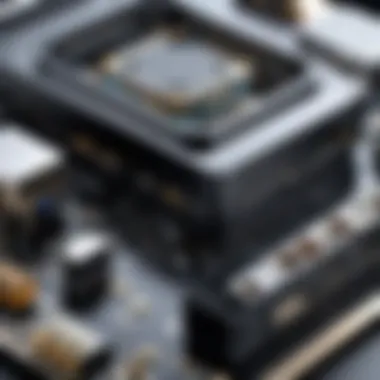
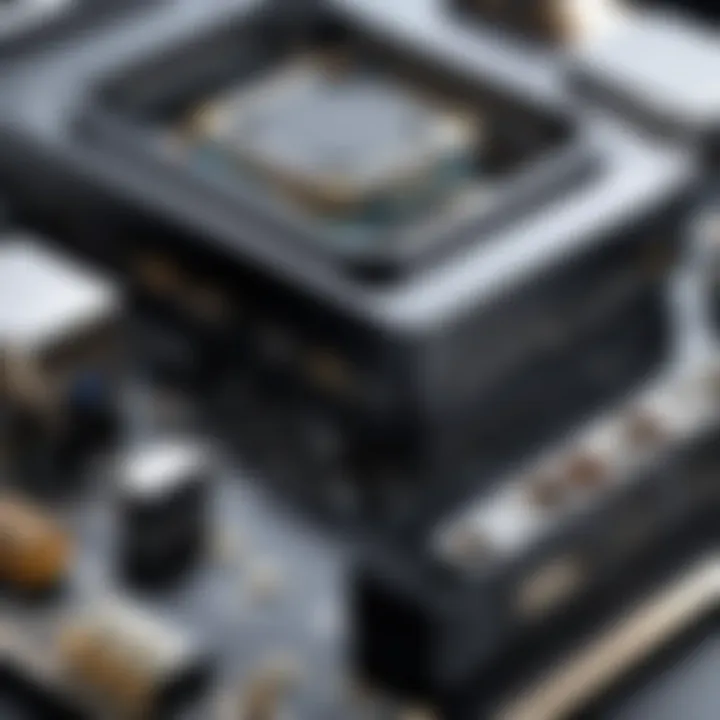
Having the right hardware is like laying a solid foundation for a house – without it, the structure can crumble. The necessary hardware for a dual monitor setup dictates performance and overall experience, guiding efficiency as you navigate your daily tasks. An optimal configuration doesn’t just depend on how well your monitors work together but also on how you select each component, from monitors themselves to cables and graphics cards.
Choosing the Right Monitors
Screen Size and Resolution
When talking about screen size and resolution, it feels a bit like discussing pizza: too small and you feel unsatisfied, too big and it gets hard to manage. Generally, a screen size of around 24 inches to 27 inches is seen as a sweet spot for dual monitor setups. A higher resolution like 1920x1080 (Full HD) or 2560x1440 (QHD) ensures that everything is sharp and clear.
In practical terms, this makes a big difference in how you see your applications. For instance, coding on a higher resolution monitor allows for more code to be displayed without scrolling. If you're visualizing large datasets, the clarity can’t be overlooked—it’s a major boost, especially during those late nights.
One unique feature of higher resolutions is that they often come with advanced color accuracy, which is crucial for graphic designers or photographers. However, users should be cautious: higher resolutions can strain your graphics card, so it’s worth checking your setup.
Panel Types and their Characteristics
Choosing the right panel type boils down to understanding the differences between IPS, VA, and TN panels. Each has its own flair; IPS panels, for instance, are widely popular because of their vibrant colors and wide viewing angles. This becomes particularly important when collaboration is key, as multiple viewers can enjoy consistent colors from various angles.
On the flip side, TN panels tend to be cheaper and offer lower response times, making them favored for gaming. However, they often compromise on color fidelity. Therefore, if the primary use is for professional work, opting for an IPS panel would likely align better with your needs. It’s all about finding that balance between what you need and your budget.
Cables and Connectors
HDMI, DisplayPort, and VGA
Cables often get overlooked but can be the silent heroes of your dual monitor experience. HDMI is prevalent and universally accepted across most devices today, which makes it a solid go-to. DisplayPort, on the other hand, provides higher bandwidth capabilities, allowing for better refresh rates and resolutions. For example, if someone is using multiple 4K monitors, DisplayPort is often the recommendation.
VGA, while still present, is slowly becoming obsolete, mainly due to its limitations in quality. This can vary depending on the age of the monitors and devices involved, sometimes leading to unwanted issues like flickering or fuzzy images. Choosing the right cable can save headaches down the line.
Understanding Connection Types
Understanding connection types is crucial when setting up your monitors. Knowing whether to go for HDMI, DisplayPort, or even USB-C can influence your experience significantly. For example, USB-C has become more prominent due to its versatility; it carries power, data, and video, streamlining the clutter in your workspace.
Additionally, while HDMI handles audio and video signals seamlessly, its limitations appear when higher resolutions and refresh rates come into play. DisplayPort again shines in this respect, handling 4K at 60Hz without breaking a sweat. Ultimately, being well-informed about each type can lead you to make better choices, ensuring everything runs smoothly.
Graphics Card Requirements
Integrated vs Dedicated Graphics
Now, getting into graphics cards, one's choice between integrated and dedicated really draws a line in the sand. Integrated graphics suffice for simple day-to-day tasks, like spreadsheets or web browsing. However, as multitasking ramps up, and you start running multiple applications simultaneously or even gaming, a dedicated graphics card becomes necessary.
Dedicated cards provide improved performance because they have their own memory to support demanding tasks. Features like multiple outputs can also come in handy for those who wish to set up several monitors. It’s a shift from just basic to a robust working environment that can handle anything you throw at it.
Checking for Compatibility
Whether you’re upgrading or starting fresh, checking for compatibility is a must. Incompatibility can lead to a frustrating setup experience. Each graphics card has specific outputs and capabilities, and mismatching these with your monitors could mean disappointment from the get-go.
A good practice is to look at the specifications of both your graphics card and monitors before making a purchase. This ensures that you won’t end up with a monitor that can’t function at full capacity. Knowledge is your safety net in the tech world, and being proactive here pays off.
Remember, a well-thought-out investment in hardware can yield substantial productivity gains.
In summary, understanding the hardware components in your dual monitor setup sets the tone for productivity. Selecting the right monitors, cables, and graphics cards tailored to your unique situation empowers you for success in creating a dual monitor workspace.
Setting Up Your Dual Monitor Configuration
Setting up your dual monitor configuration is one of the most crucial steps in maximizing the efficiency of your workspace. Getting it right not only enhances your productivity but also ensures a comfortable working environment. It’s the fine details that can make a world of difference. A well-thought-out setup vastly improves how you tackle tasks, from coding to graphic design.
Physical Arrangement of Monitors
Optimal Positioning Techniques
When it comes to positioning your monitors, it's all about finding the right fit for you. The core insight lies in how you plan to interact with both screens. Many professionals opt for a slight angle, facing inward. This setup mirrors a natural field of vision and can lessen neck strain. Furthermore, it's often said that having your monitors placed side by side can create a more immersive experience. If your monitors are too far apart, you might find yourself straining to switch between screens, which could dramatically slow you down.
One unique aspect to explore is the height of the monitors. Keeping them at eye level is usually a popular choice because it aligns everything with your natural gaze. This approach benefits your posture and reduces fatigue during long hours of work. However, if your monitors are positioned too high or low, you might start feeling discomfort, creating a barrier to achieving peak productivity.
Adjusting for Eye Level
Adjusting for eye level is where ergonomic principles shine in importance. Ideally, the top of your monitor should be inches above your eye level. This placement reduces the weight on your neck and minimizes back problems. Those who spend long hours in front of screens will find adopting this standard a game changer. It’s a small adjustment that can yield big dividends in the long run.
Moreover, having your screens at the correct eye level permits a more relaxed posture. This small shift helps you maintain focus and stay engaged longer. When discussing the various ways to optimize monitor positioning, the eye-level adjustment is universally touted as one of the best practices.
Connecting Monitors to Your Computer
Connecting your monitors involves understanding the ports and cables required. You might think this is straightforward, but complications can arise based on the age and types of devices involved. Ensure you have the appropriate cables such as HDMI, DisplayPort, or even a VGA cable if applicable. It’s essential to check compatibility before making any assumptions here.
Once you've identified the necessary cables, plug them into the respective ports on your graphics card or motherboard. This step is vital and serves as your gateway to an extended workspace. Make sure everything is secure, as a wobbly connection might lead to intermittent issues.
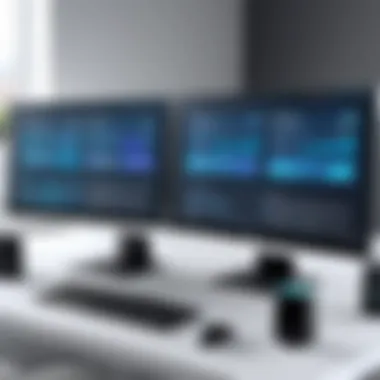
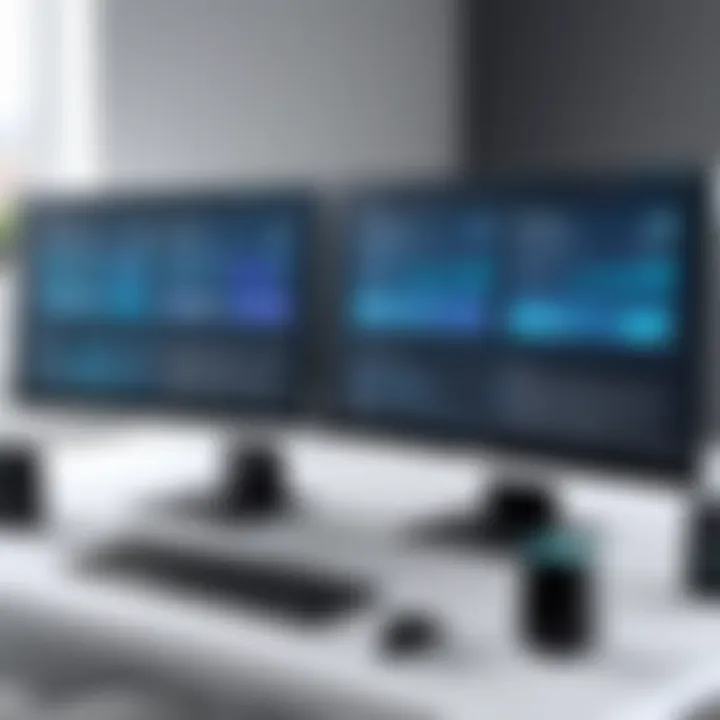
Configuring Display Settings
Configuring display settings can seem like a daunting task if you're not tech-savvy, but it’s really about customizing your experience.
Adjusting Resolution and Orientation
Adjusting your screens’ resolution and orientation plays a significant role in how efficiently you work. Each monitor should ideally be set to its native resolution to enjoy an optimized viewing experience. If one screen is set too low, it may lead to pixelation, thus making it harder to read text or spot detailed images. Stick with the manufacturer’s recommendation when possible.
In addition, orientation settings—whether landscape or portrait—can shift the way you manipulate applications. For example, portrait mode can be beneficial for reading long documents or coding. Having the right orientation for your work can help you navigate through tasks seamlessly or make data comparisons much more fluid.
Setting Primary vs Secondary Displays
The decision of which display to set as primary versus secondary can often feel like small potatoes; however, it greatly influences your workflow. Your primary display will be where your taskbar and main applications reside, while the secondary serves as an extension or support space.
To set this up, head to your display settings within the operating system you are using. You’ll find options to identify your displays, allowing you to choose which monitor will act as the main hub. This choice can streamline your workflow, especially when using applications that require constant referencing between screens.
You should strive to make this choice based on how you work best. If you constantly reference the secondary display for notes or tools, keeping it where it's easily visible will be more beneficial.
Software Considerations
When embarking on the journey of setting up a dual monitor configuration, the choice of software can be as crucial as the hardware itself. Proper software considerations play a significant role in ensuring that the dual monitors operate harmoniously and efficiently, transforming your workspace into a productivity powerhouse. Here are some of the main points to delve into:
Operating System Support
Windows
Windows holds a prominent place in the realm of operating systems, and for good reason. It offers robust support for multiple monitors, making it a favored choice for many who opt for dual setups. One of the key characteristics that sets Windows apart is its ease of use. With simple configuration steps, users can adjust their display settings with just a few clicks.
The unique feature of Windows is the ability to extend the desktop across multiple screens seamlessly, allowing users to drag applications from one monitor to another. This streamlined flexibility contributes significantly to the overall goal of boosting productivity. However, it's worth noting that some versions may have limitations—like screen resolution support—depending on the hardware configuration, which could be a downside for high-spec users.
macOS
On the other hand, macOS presents its own touch of sophistication. Known for its clean user interface, macOS supports dual monitors with a high degree of compatibility. The key characteristic of macOS lies in its seamless integration with Apple's hardware, such as the MacBook Pro and iMac. A unique feature of macOS is the way it handles multiple displays through a distinct Spaces functionality, allowing users to create virtual desktops for better organization. This can be crucial for professionals who deal with various applications at once. Nonetheless, the cost of entry can be a hurdle; Apple equipment typically comes with a premium price tag, which could deter some users.
Linux Distros
Linux Distros represent yet another diverse option. They offer a unique blend of customization and open-source flexibility. The key characteristic of many Linux distributions is their ability to cater to various user needs, from lightweight setups to fully fledged workstations. One fascinating feature of Linux Distros is their extensive configurability regarding screen arrangement and desktop environments. This allows tech enthusiasts to truly tailor their dual monitor setup to their specific workflow. However, potential disadvantages include a steeper learning curve, especially for those not well-versed in terminal use or command-line operations, as well as varied support for different hardware across distributions.
Managing Multiple Applications
Managing multiple applications efficiently is vital for maximizing the potential of a dual monitor setup. This aspect can significantly influence workflow and productivity.
Virtual Desktops
A standout tool in this domain is Virtual Desktops. They allow users to create separate workspaces, which can be incredibly useful when juggling various tasks. The key characteristic that makes Virtual Desktops beneficial is their ability to keep tasks organized by project type or focus area. This way, users can switch contexts without losing sight of what they were doing.
One unique feature of Virtual Desktops is their potential to enhance focus. By isolating applications tailored to specific tasks, distractions can be minimized. However, managing too many desktops may lead to confusion, particularly for users who aren't familiar with navigating between them.
Taskbar Management
Taskbar Management is another crucial element to enhancing dual monitor setups. With an expanded workspace, having quick access to running applications is essential. A key characteristic of effective taskbar management is the ability to customize where and how icons are displayed across multiple screens.
One of the distinct advantages of solid taskbar management solutions is the organization they bring to the user experience. Users can keep essential applications at their fingertips, enhancing efficiency when navigating between tasks. However, this can also be a double-edged sword; overcrowding the taskbar may lead to a cluttered interface, undermining the very objectives of a dual monitor setup.
Effective software considerations are crucial to harnessing the real power of dual displays. Proper management of both the operating systems and applications can elevate the user experience, leading to enhanced focus and productivity.
Ergonomics and Workspace Optimization
Establishing a dual monitor setup goes beyond just connecting hardware; it involves careful consideration of how you interact with this expanded workspace. Ergonomics is concerned with designing the workspace to fit the user, promoting comfort, efficiency, and productivity. Hence, optimizing your workspace isn’t just about aesthetics, it could significantly affect your health, focus, and performance.
When setting up your dual monitors, the placement, distance from your eyes, and your seating position are crucial. Getting these factors right can help reduce strain and prevent long-term issues like neck pain or eye fatigue. By focusing on ergonomics, you can ensure that your work environment supports you rather than hinders you, thus maximizing the benefits of a dual monitor setup.
Adjusting Screen Height and Distance
Finding the perfect height and distance for your monitors is an art and science blended together. Ideally, the top of your screens should be at or slightly below eye level. When you sit upright, your gaze should be directed slightly downward at the center of the screens. This helps to reduce neck strain and ensures that you maintain proper alignment throughout your workday.
Here’s how to adjust your screen height and distance effectively:
- Monitor Stands: Use adjustable monitor stands or mounts.
- Distance from Eyes: Keep monitors about an arm’s length away. Adjust based on focal requirements; some activities may necessitate closer or further monitor positioning.
- Multiple Monitors: If using more than one monitor, ensure they are positioned side by side at the same height to discourage awkward neck movements.
- Tilt and Orientation: Angle your monitor slightly to reduce glare. The screen should not be perpendicular; a slight tilt can make a big difference.
"A well-adjusted workspace not only enhances productivity but also promotes long-term health benefits."
Maintaining a Healthy Posture
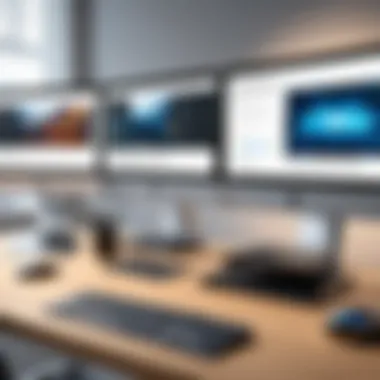
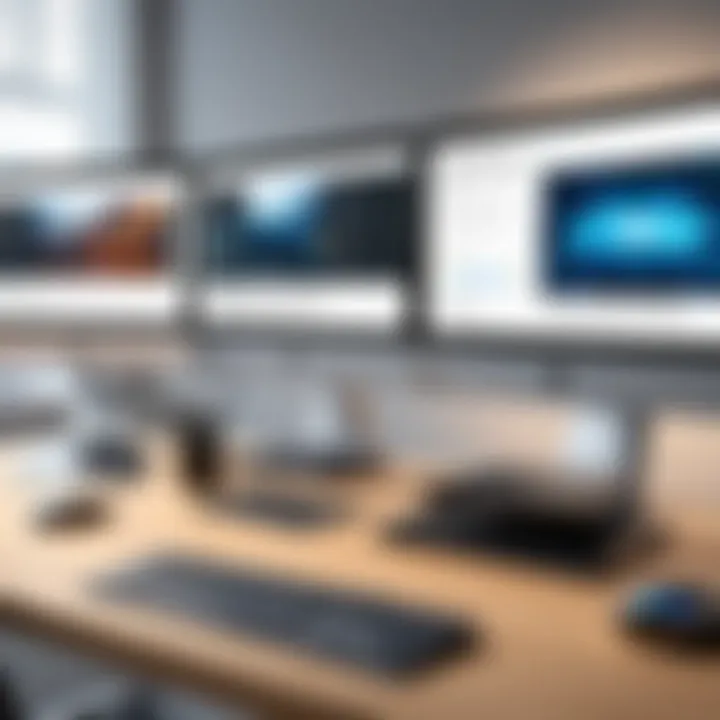
Posture is the unsung hero of workplace efficiency. Even the best dual monitor setup won’t save you if you’re hunched over or slouched in your chair. Being aware of how you sit can make all the difference in not just how you work, but how you feel while doing it.
To maintain a healthy posture when using dual monitors, follow these tips:
- Feet Flat on the Ground: Your feet should be flat on the floor, or use a footrest if necessary. This promotes better circulation.
- Back Support: Invest in a chair that supports the natural curve of your back. An ergonomic chair can do wonders.
- Shoulder Relaxation: Keep shoulders relaxed and your arms close to your body. They should ideally form a 90-degree angle at the elbows.
- Regular Breaks: Stand up, stretch, and change positions frequently. It’s vital to allow your muscles to relax and recover from the continuous strain.
Proper ergonomics and workspace optimization not only make your dual monitor setup more effective, but they also help to prolong your career in technology by keeping you comfortable and healthy. Attention to these details paves the way for a better working experience in the tech domain, ultimately translating into increased focus and productivity.
Troubleshooting Common Issues
When working with a dual monitor setup, facing technical issues can be a real buzzkill. From display detection failures to scaling misalignments, these problems can disrupt your workflow, leaving you pulling your hair out instead of kicking back and getting things done. Understanding how to troubleshoot common issues is essential for any tech enthusiast or IT professional aiming to make the most of their dual monitor configuration. It’s not just about having more screens; it’s about making sure they function smoothly together.
Display Not Detected
One of the most frustrating problems is when your computer doesn’t recognize one of your monitors. This can happen for several reasons. Initially, ensure all cables are snugly connected. It might sound trivial, but loose connections are the main culprit here. Additionally, confirm that both monitors are powered on. Sometimes a simple switch can solve the mystery.
If everything appears correct on the surface, it might be a driver issue. Head over to your graphics card’s manufacturer website, like NVIDIA or AMD, to download the latest drivers. Outdated drivers can lead to compatibility issues, causing your system to overlook the additional screen.
If after all this, the problem persists, dive into the display settings on your operating system. In Windows, for instance, right-click on the desktop, select Display settings, and click on Detect. This might force the system to recognize the monitor.
"Sometimes technology feels like a stubborn beast; all you need is a little finesse to tame it."
Resolution and Scaling Problems
Misconfigured resolutions can turn your dual monitor experience into a frustrating game of pixel hopscotch. Each monitor might have differing specifications – one may be 1080p while the other is 4K, leading to a mismatch when it comes to display scaling.
For Windows users, navigating to the Display settings again can be beneficial. You will often find options to adjust the scale and layout for each monitor. Choose resolutions fitting for each display, making sure they don’t look squished or stretched. As a best practice, try matching the scaling percentages unless necessary otherwise; this ensures a more cohesive look and feel across your screens.
On the other hand, macOS users can adjust their display configurations by going to System Preferences and then to Displays. Here, you can change resolutions and scaling options to align both displays beautifully. Keeping in mind how particular applications behave on each screen can also be critical; sometimes, a small tweak can improve the overall experience.
Performance Issues
If multitasking feels like dragging a ton of bricks uphill, you might be facing performance bottlenecks. A dual monitor setup can strain your system resources, particularly if your graphics card isn't robust. If your programs lag or stutter, it's a loud signal that your systems need reinforcement.
Start by monitoring resource utilization using either built-in task managers or third-party software. High CPU or GPU usage can indicate that you need a better graphics card or more RAM. Additionally, closing unnecessary applications running in the background can free up resources.
For a more technical approach, consider tweaking system settings or engaging specific performance enhancements that your OS may offer. For instance, in Windows, adjusting the Graphics settings can help you choose which apps benefit most from dedicated graphics resources. Having a smooth sailing dual monitor experience requires not just setting it up but ensuring that the brain behind the operation – your computer – can handle the load.
Troubleshooting can feel complicated, but knowing common issues empowers you to tackle them head-on. By understanding what might go wrong and how to fix it, you'll ensure your dual monitor setup remains a potent tool in your productivity arsenal.
Future Trends in Dual Monitor Technology
As we navigate an era fueled by rapid advancements in technology, the realm of dual monitor setups is no exception. The topic of future trends is paramount, as it unveils the trajectory of how we interact with our workspaces. In this section, we will delve into noteworthy developments that promise to reshape how dual monitors function and enhance user experience. Emerging technologies not only elevate productivity but also redefine workspace aesthetics and ergonomic approaches.
Advancements in Monitor Technology
Ultra-Wide Monitors
Ultra-wide monitors have taken the tech world by storm. These screens, often boasting a 21:9 aspect ratio or even wider, offer an immersive experience that traditional dual monitors struggle to match. A key characteristic is the seamless display, allowing users to multitask without the distraction of bezels that separate screens in a standard dual setup. This singular expansive view enables programmers and designers to see their entire workspace at a glance.
The unique feature of ultra-wide monitors is their ability to display multiple applications side by side. Imagine programming on one end, while keeping documentation open on the other, all without losing sight of either. This not only saves physical space but enhances workflow efficiency. However, users must consider the potential drawbacks, such as the initial investment cost and the need for powerful graphic output to fully leverage the capabilities of these displays.
OLED vs LED Technologies
The debate between OLED and LED technologies continues to rage as both offer compelling advantages. OLED screens stand out due to their ability to produce vibrant colors and deep blacks, leading to superior image quality. A notable characteristic of OLED is its ability to render faster response times, which is vital for fast-paced gaming or video editing tasks. It enhances visual clarity, making it a popular choice among creative professionals.
However, the life span of OLED can be a concern, as burn-in phenomena may occur if static images are displayed for extended periods. LED, on the other hand, is known for its durability and energy efficiency, making it less prone to image retention. This technology excels when used for diverse tasks and long hours on the job. Each choice has its merits and flaws, and it depends largely on user requirements, whether they prioritize cost-effectiveness or visual fidelity.
Emerging Software Solutions
As technology evolves, so does the software that utilizes these advancements. Emerging software solutions are paving the way for enhanced productivity, especially in dual monitor setups.
Virtual Reality Integration
Virtual reality integration presents a fascinating opportunity in multi-monitor environments. By immersing users in a virtual workspace, it enhances focus and reduces distractions typically found in a physical office. A key characteristic is the interaction capacity with different applications in a 3D space, allowing for innovative ways to visualize and manage tasks. For tech enthusiasts and IT professionals, this is an enthralling concept as it could redefine traditional workflows.
However, VR poses some challenges, including hardware requirements and potential feelings of disorientation after prolonged exposure. The sophistication of the technology might necessitate a steep learning curve for some users, but the potential gains could far outweigh such hurdles.
AI-driven Workspace Management
AI-driven workspace management is on the rise and offers exciting prospects for dual monitor users. Smart systems can now track user behavior and suggest how to arrange applications for maximum efficiency. This characteristic of adaptive learning is invaluable for those juggling multiple projects, enabling a streamlined workflow tailored to individual habits.
A unique feature of AI management is its capability to automate repetitive tasks. By integrating AI into dual monitor setups, users can focus on more creative or strategic tasks, enhancing overall productivity. However, users must also remain aware of potential data privacy concerns, as reliance on AI systems requires an openness to sharing personal usage patterns.
In summary, the future of dual monitor technology is rich with opportunities and considerations. Advances like ultra-wide monitors and OLED or LED technologies, combined with software innovations such as virtual reality and AI-driven solutions, are set to transform how we approach our work environments.
"Embrace the shift, as the tools we choose today shape the workflows of tomorrow."
Understanding these emerging trends allows IT professionals and tech enthusiasts to make informed decisions that elevate their workspace efficiency and effectiveness.



